2022届高考英语二轮复习:动词的总结性课件(56张)
文档属性
| 名称 | 2022届高考英语二轮复习:动词的总结性课件(56张) | 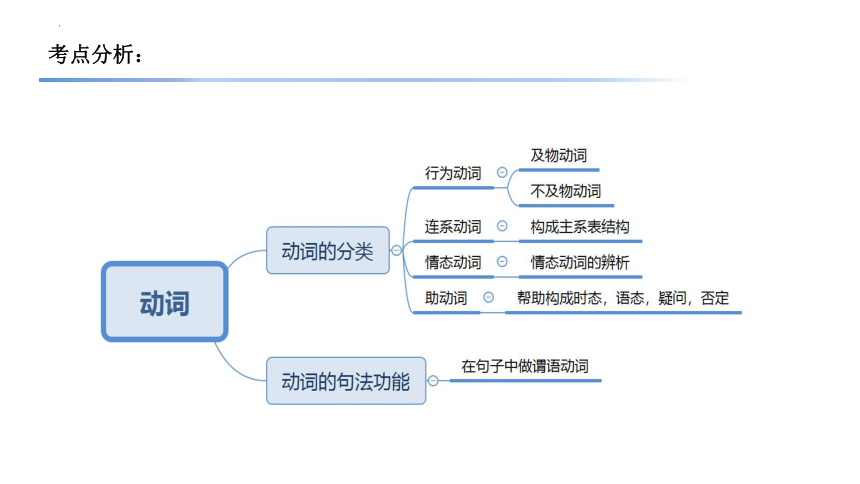 | |
| 格式 | pptx | ||
| 文件大小 | 238.4KB | ||
| 资源类型 | 教案 | ||
| 版本资源 | 通用版 | ||
| 科目 | 英语 | ||
| 更新时间 | 2022-03-02 16:33:22 | ||
图片预览

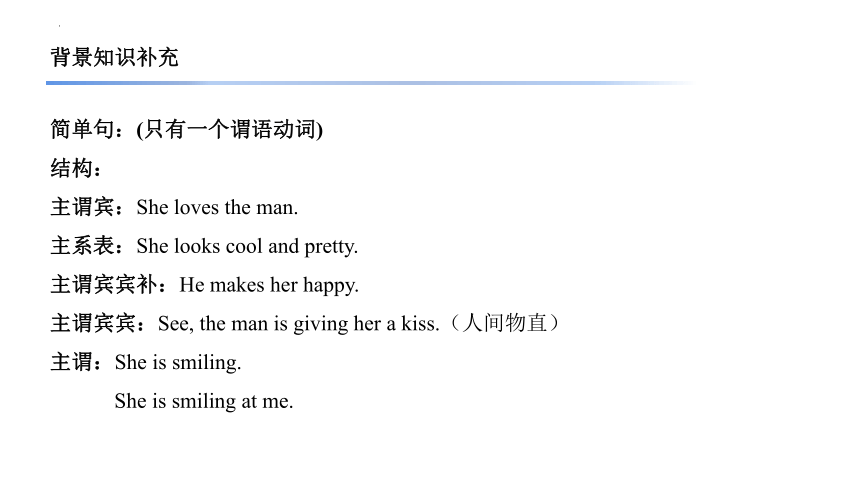
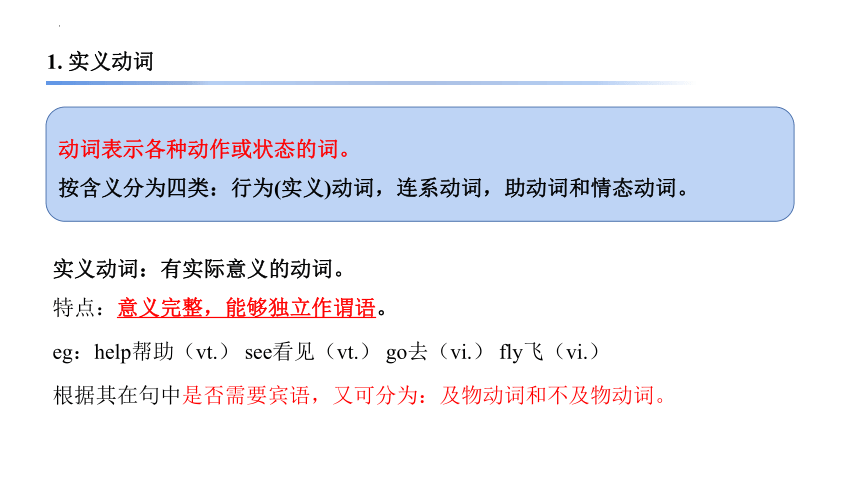

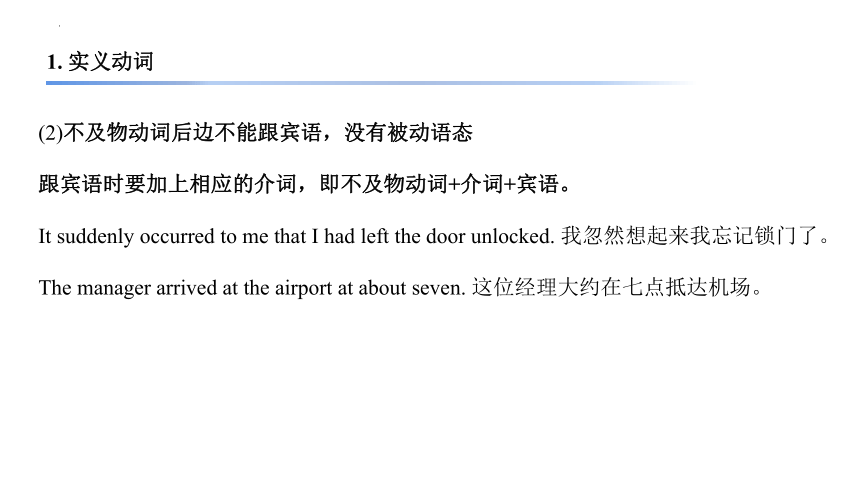
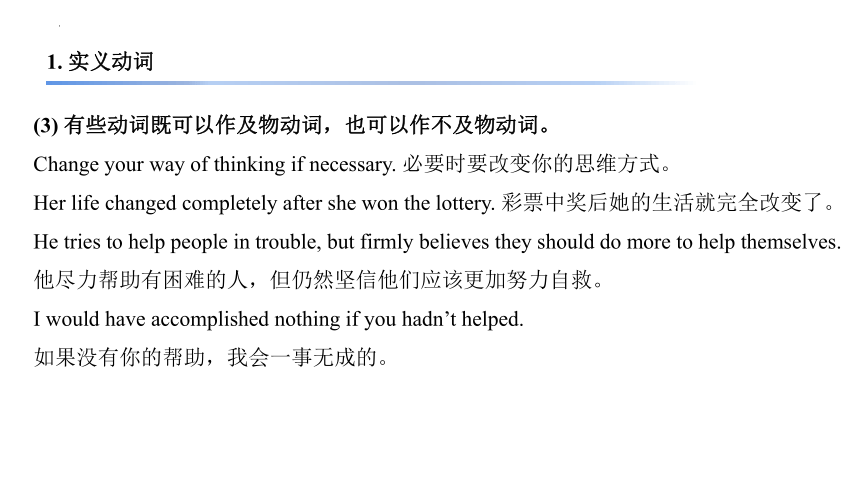



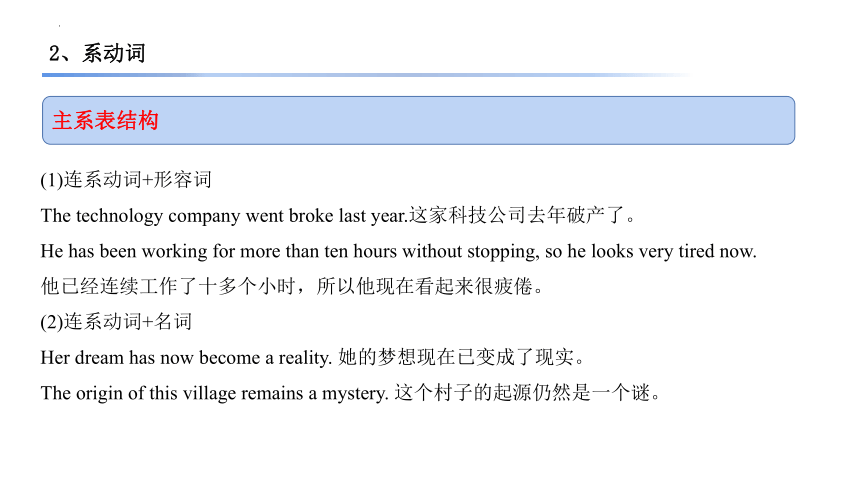
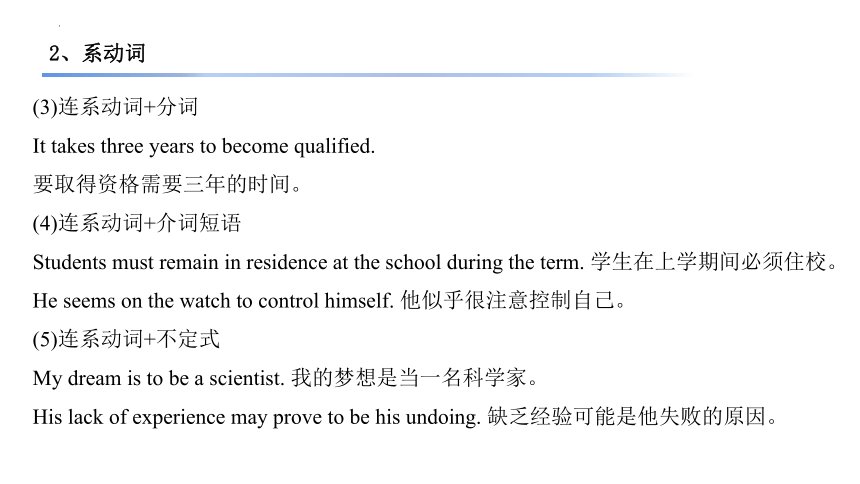

文档简介
(共40张PPT)
考点分析:
背景知识补充
简单句:(只有一个谓语动词)
结构:
主谓宾:She loves the man.
主系表:She looks cool and pretty.
主谓宾宾补:He makes her happy.
主谓宾宾:See, the man is giving her a kiss.(人间物直)
主谓:She is smiling.
She is smiling at me.
1. 实义动词
实义动词:有实际意义的动词。
特点:意义完整,能够独立作谓语。
eg:help帮助(vt.) see看见(vt.) go去(vi.) fly飞(vi.)
根据其在句中是否需要宾语,又可分为:及物动词和不及物动词。
动词表示各种动作或状态的词。
按含义分为四类:行为(实义)动词,连系动词,助动词和情态动词。
1. 实义动词
(1)及物动词(vt.)
①后面能直接跟宾语。
I learn English every day.(English是learn的宾语)我每天都学英语。
Mark was trying to convey his idea of a geometric point.
马克试图表达他的一个几何学观点。
②可以用于被动语态。
The soldier was given a warm send-off by his family.士兵受到他家人的热烈欢送。
1. 实义动词
(2)不及物动词后边不能跟宾语,没有被动语态
跟宾语时要加上相应的介词,即不及物动词+介词+宾语。
It suddenly occurred to me that I had left the door unlocked. 我忽然想起来我忘记锁门了。
The manager arrived at the airport at about seven. 这位经理大约在七点抵达机场。
(3) 有些动词既可以作及物动词,也可以作不及物动词。
Change your way of thinking if necessary. 必要时要改变你的思维方式。
Her life changed completely after she won the lottery. 彩票中奖后她的生活就完全改变了。
He tries to help people in trouble, but firmly believes they should do more to help themselves.
他尽力帮助有困难的人,但仍然坚信他们应该更加努力自救。
I would have accomplished nothing if you hadn’t helped.
如果没有你的帮助,我会一事无成的。
1. 实义动词
More and more noise pollution ______ many species dying out.
A.results in B. results from C. is resulted in D. is resulted from
result in:造成,导致。+结果。
result from:起因于,由......造成。+原因。
考点链接
1. 实义动词
短暂性动词:没有持续性,一发生就结束。也称为非延续性动词,终止性动词。
不能和表示一段时间的时间状语连用。
go, come, leave, arrive, lose, land(着陆), catch, join, kill, find, occur, happen等。
He has joined the club for a long time. (╳)
He has been a member of the club for a long time.
他加入这个俱乐部已经很长时间了。
持续性动词:可以持续发生。
He slept for ten hours.他整整睡了十个小时。
根据动作是否具有持续性,可以分为短暂性动词,和延续性动词。
2、系动词
系动词:词义不完整,须接表语构成系表结构,说明主语的状态、性质、特征或身份。系动词没有被动语态,也不用于进行时。
be动词:表示“是”的时候。He is a good student.
感官动词:look, sound, smell, taste, feel.
变得、成为:become, get, turn , grow等
似乎、好像:seem, appear等
保持:keep, stay, remain等
(1)连系动词+形容词
The technology company went broke last year.这家科技公司去年破产了。
He has been working for more than ten hours without stopping, so he looks very tired now.
他已经连续工作了十多个小时,所以他现在看起来很疲倦。
(2)连系动词+名词
Her dream has now become a reality. 她的梦想现在已变成了现实。
The origin of this village remains a mystery. 这个村子的起源仍然是一个谜。
2、系动词
主系表结构
(3)连系动词+分词
It takes three years to become qualified.
要取得资格需要三年的时间。
(4)连系动词+介词短语
Students must remain in residence at the school during the term. 学生在上学期间必须住校。
He seems on the watch to control himself. 他似乎很注意控制自己。
(5)连系动词+不定式
My dream is to be a scientist. 我的梦想是当一名科学家。
His lack of experience may prove to be his undoing. 缺乏经验可能是他失败的原因。
2、系动词
情态动词主要用于表明说话者对某一行为的态度和观点,包括能力、可能、义务、必要、猜测、责备等。①情态动词是辅助性动词,不能单独使用,必须和动词原形一起构成谓语。②情态动词没有人称和数的变化,但是有时态变化。
3、情态动词
3、情态动词
1.can ( could) 和be able to
can 可以表示“能,会”,could是它的过去时;没有其他时态。
be able to也表示“能,会”, 可用于各种时态。
Can you play the violin =Are you able to play the violin
We’ll be able to have a two-week holiday soon. 我们很快就会有一个为期俩周的假期。
He said that he could do anything we wished.
He has been able to finish the work on time.他已经能按时完成工作了。
can也可以表示对现在或将来的推测,常用于否定句和疑问句中
That can’t be true.
3、情态动词
1.can ( could) 和be able to
(1) be able to 强调通过努力而获得的能力,而can则强调自身已具有的能力。
She can sing the song in English. 她能用英语唱这首歌。
He will be able to sing this song in English in a few minutes, too.
(2) be able to 强调一种结果,而can只强调一种可能。
Luckily, he was able to escape from the big fire in the end.
幸运的是,他终于逃出了大火。
If he got here a few hours earlier, I could save him.
要是他早几小时来,我还能救他。
3、情态动词
1.can ( could) 和be able to
“can / could + have +过去分词” 过去可能;
过去本能做某事却没有做(虚拟)
“cannot/could not+have+过去分词” 表示过去不可能发生的事。
But we could have done it all so much better. 但我们本可以把这一切做的更好。
John could have been seriously hurt in the accident. 约翰可能在那次事故中受了伤。
You can’t /couldn’t have seen her in the office last Friday.上周五你不可能在办公室看见她。
That thing can’t be true.那件事不可能是真的。
-You must finish this essay today.
-I’m trying my best, but I’m afraid I ______ finish it in such a short time.
A.mustn’t B. can’t C. needn’t D. shouldn’t
考点链接
考点链接
I ______ my examination easily, but I made too many stupid mistakes.
A. must pass B. must have passed C. would pass D. could have passed
3、情态动词
2、may和 might 的用法
①may可以“许可、 可以” ,它的过去式是might,might比may的语气更婉转
Visitors may not walk on the grass in the garden.
表肯定回答时,可用“Yes, please do.” 或“Yes, you may”,通常不用You might.
- May I come around in the morning -Yes, please do.
②回答问题表示“不许可” 时,可用can’t或may not
-Can I be excused from the meeting
- No, you can’t.
- May I use your dictionary for about two hours
- No,you may not.
3、情态动词
2、may和 might 的用法
③表示“可能” 时,may表示的可能性比might表示的可能性大
Tom may lend Lily the novel. Tom might lend Lucy the novel.
(Lily和Lucy相比,Tom 更可能把小说借给前者)
④“may / might have +过去分词” 表示对过去发生事情的一种猜测,“可能”
They may/might have called while you were out.你出去时他们可能打过电话。
You may / might have read that exciting news reported yesterday.
The two may / might not have met that night.
He ______ something wrong, but we respect him just the same.
A.should do B. would have done C. may have done D. must do
考点链接
3、情态动词
3. have to和must
表示必须,不得不。must强调主观看法,表示说话人主观上认为有必要做某事。
have to 强调客观需要,表示客观环境促使其不得不做某事。
I must learn another language.(我想要)
I have to learn another language.(不得不)
Thomas has seven kids, so he ______ work hard to support such a big family.
A. must B. could C. may D. has to
考点链接
3、情态动词
3. have to和must
所用时态不同:have to有多种时态形式,也可用于被动语态; must只有现在时一种形式(在宾语从句中可以表示过去)
The sports meeting had to be put off because of the bad weather.
He said she must go with me.
3、情态动词
3. have to和must
否定式的意义不同:have to的否定式don’t have to = needn’t 意为“不必”;而must的否定式mustn’t 意为“禁止、一定不要、 不允许”。
You needn’t tell him about it.你不必告诉他这件事。( 他可能知道了)
You mustn’t tell him about it.你一定不 要告诉他这件事。(这是秘密)
must +动词原形。表示对现在情况的肯定推测。
He must be either mad or drunk.
3、情态动词
3. have to和must
must表示的推测含有极有把握的意思,通常只用于肯定式中,其否定和疑问式多用can / could来表示。
He must be at home. He can’t be in the office.
⑤表示对过去情况的肯定推测用must+ have +过去分词,表示“肯定做了”。
其否定式是can / could not+ have +过去分词,表示“不可能发生”。
不存在mustn’t have done形式。
You must have gone to bed late last night, for your eyes are red.
你昨晚一定睡的很晚,因为你的眼睛都红了。
Mary can’t have appeared in the office, because she has already gone home.
玛丽不可能出现在办公室,因为她已经回家去了。
考点链接
From what you said, she _______ you all about it.
A . must tell
B . must be telling
C. tells
D. must have told
3、情态动词
4、should和ought to
should 和ought to 表示应该,应当。 should 语气较轻;ought to 语气较重,没有词形变化,适用于所有人称和时态,to后面应该跟动词原形。
Children should be able to read by the age of 7.
The rain has stopped, it ought to be warmer.雨停了,天气就会暖和点了。
3、情态动词
should/ought to have +过去分词:本应该做某事。
shouldn’t/oughtn’t to have +过去分词:本不应该做某事。
4、should和ought to
You shouldn’t have been following him so closely; you should have kept your distance.
你本不应该一直这样紧跟着他,你本应该保持距离。
You ought to have told him that the paint on that seat was wet.
你本应该告诉他那个座位上的油漆还没没有干。
You oughtn’t to have given him more help.
你本不该给他更多帮助的。
考点链接
I regret having left the work unfinished; I _________ everything ahead carefully.
should have planned
must have planned
might have planned
could have planned
3、情态动词
should have done, ought to have done表示对过去情况的推测, “应当已经…”。
It’s ten o’clock. She should have arrived at her office by now.
10点了,她此刻应该已经到办公室了。
Two weeks ago I sent him a book. Now he ought to have received it.
俩星期前我给他寄了一本书。现在他应该已经收到了。
4、should和ought to
3、情态动词
5、情态动词dare和行为动词dare.
行为动词:敢于。
否定式:在前面加don’t ,didn’t, doesn’t.
一般疑问句:借助 did, do, does.
敢做某事:dare+to do sth.
激励,怂恿某人做某事: dare sb to do sth.
He didn’t dare to say what he thought.他不敢说出自己的想法。
She dares to swim in the river.她敢在那条河里游泳。
I dare him to jump in to the river. 我激他跳到了河里。
3、情态动词
情态动词dare:
没有人称和数的变化;后接动词原形;否定式为dare not+动词原形,缩写为daren’t;用于疑问句不必在句首加do/does/did.
Dare you disobey what your boss says
How dare you take my computer without even asking!
They dare not ask for any more money.他们不敢再要更多的钱了。
She never dare speak in public. 她从不敢在公众面前讲话。
5、情态动词dare和行为动词dare.
3、情态动词
6、情态动词need和行为动词need
①情态动词need:
A.没有人称和数的变化;后接动词原形;否定式为need not=needn’t,表“不必”
There need be no hurry, need there
You needn’t go if you don’t want to.
He needn’t come if he is busy.
B.“needn’t have+过去分词” 表示本不必。
The weather here is very warm. We needn’t have packed these woolen sweaters.
这里的天气很暖和。我们不必把这些羊毛衫打包
Your son is doing fine at school. You needn't have been worrying so much about him.
3、情态动词
②行为动词need:
A.有人称和数的变化;后接不定式;在否定句中按实际需要在其前面加上don’t/ doesn’t/ didn’t;在疑问句中句首必须按实际情况加上do / does / did
He doesn’t need to finish his work report today.
Do I need to tell him about it
need to do sth需要做某事
He needs to finish it this evening.他今晚需要完成它。
need doing sth 动名词表示被动
Your room needs cleaning. = Your room needs to be cleaned.
结构 意义 用法 例句
may have done might have done 可能已经 表示对过去发生事情的推测 She said that he might have missed the plane.
must have done 肯定已经 表示对过去发生事情的肯定推测 There must have been no one in, for nobody answered the phone.
could have done 本来能够 表示过去本能做而没有做,含有对过去未付诸实践的事情的遗憾或责备 In those circumstances we could have done better.
should have done ought to have done 本来应该 表示本应该做的事情却没有做 You should have told me earlier. I could have helped you.
can’t have done couldn’t have done 不可能,不会 表示对过去已经发生事情的否定推测 He can’t/ couldn’t have worked out the problem.
shouldn’t have done oughtn’t to have done 本来不应该 表示本不该发生的事情却发生了,含有责备或后悔之意 They have done things that they oughtn’t to/ shouldn’t have done.
needn’t have done 本没必要 表示本没必要做某事,但实际上做了 I needn’t have gone to the station.
4. 助动词
特点:本身无词汇意义或意义不完全,不能单独用作谓语。助动词有be, have, shall(should), will(would)和do等等。助动词在句中与实义动词一起构成各种时态、语态以及否定和疑问结构。
表示时态 He is singing. 他在唱歌。
He has got married. 他已结婚。
表示语态 He was sent to England. 他被派往英国。
构成疑问句 Do you like college life 你喜欢大学生活吗?
构成否定句 I don't like him. 我不喜欢他。
4. 助动词
助动词be 肯定(缩略) 否定 缩略否定
原形 没有时态、 人称、数的变化 be not be 无
现在式 第一人称单数 am (’m) am not (’m not)
第三人称单数 is (’s) is not isn’t (’s not)
第二人称单复数、第一三人称复数 are (’re) are not aren’t(’re not)
过去式 第一三人称单数 was was not wasn’t
第二人称单复数、第一三人称复数 were were not weren’t
分词 现在分词(不分人称、数) being not being 无
过去分词(不分人称、数) been not been 无
(1)助动词be有下列几种形式:
4. 助动词
肯定(缩略肯定) 否定 缩略否定
原形 have(’ve) have not haven’t(’ve not)
现在式第三人称单数 has(’s) has not hasn’t(’s not)
过去式 had(’d) had not hadn’t(’d not)
现在分词 having not having
过去分词 had
(2)助动词have有下列几种形式:
助动词have与过去分词一起构成各种完成时态。
4. 助动词
肯定 否定 缩略否定
原形 do do not don’t
现在式第三人称单数 does does not doesn’t
过去式 did did not didn’t
(3)助动词do有下列几种形式:
助动词do的功能有四个:构成疑问句、否定句,作代动词和加强语气。
(4)助动词will(过去式是would)和shall(过去式是should)有下列几种形式:
助动词will(would)和shall(should)用于构成一般将来时和过去将来时态。will(would)可用于一切人称,shall(should)用于第一人称,较正式,现今多代之以will(would)。
肯定 缩略肯定 否定 缩略否定
任何人称 原形 will ’ll will not won’t(’ll not)
过去式 would ’d would not wouldn’t(’d not)
第一人称 原形 shall ’ll shall not shan’t(’ll not)
过去式 should ’d should not shouldn’t(’d not)
4. 助动词
考点分析:
背景知识补充
简单句:(只有一个谓语动词)
结构:
主谓宾:She loves the man.
主系表:She looks cool and pretty.
主谓宾宾补:He makes her happy.
主谓宾宾:See, the man is giving her a kiss.(人间物直)
主谓:She is smiling.
She is smiling at me.
1. 实义动词
实义动词:有实际意义的动词。
特点:意义完整,能够独立作谓语。
eg:help帮助(vt.) see看见(vt.) go去(vi.) fly飞(vi.)
根据其在句中是否需要宾语,又可分为:及物动词和不及物动词。
动词表示各种动作或状态的词。
按含义分为四类:行为(实义)动词,连系动词,助动词和情态动词。
1. 实义动词
(1)及物动词(vt.)
①后面能直接跟宾语。
I learn English every day.(English是learn的宾语)我每天都学英语。
Mark was trying to convey his idea of a geometric point.
马克试图表达他的一个几何学观点。
②可以用于被动语态。
The soldier was given a warm send-off by his family.士兵受到他家人的热烈欢送。
1. 实义动词
(2)不及物动词后边不能跟宾语,没有被动语态
跟宾语时要加上相应的介词,即不及物动词+介词+宾语。
It suddenly occurred to me that I had left the door unlocked. 我忽然想起来我忘记锁门了。
The manager arrived at the airport at about seven. 这位经理大约在七点抵达机场。
(3) 有些动词既可以作及物动词,也可以作不及物动词。
Change your way of thinking if necessary. 必要时要改变你的思维方式。
Her life changed completely after she won the lottery. 彩票中奖后她的生活就完全改变了。
He tries to help people in trouble, but firmly believes they should do more to help themselves.
他尽力帮助有困难的人,但仍然坚信他们应该更加努力自救。
I would have accomplished nothing if you hadn’t helped.
如果没有你的帮助,我会一事无成的。
1. 实义动词
More and more noise pollution ______ many species dying out.
A.results in B. results from C. is resulted in D. is resulted from
result in:造成,导致。+结果。
result from:起因于,由......造成。+原因。
考点链接
1. 实义动词
短暂性动词:没有持续性,一发生就结束。也称为非延续性动词,终止性动词。
不能和表示一段时间的时间状语连用。
go, come, leave, arrive, lose, land(着陆), catch, join, kill, find, occur, happen等。
He has joined the club for a long time. (╳)
He has been a member of the club for a long time.
他加入这个俱乐部已经很长时间了。
持续性动词:可以持续发生。
He slept for ten hours.他整整睡了十个小时。
根据动作是否具有持续性,可以分为短暂性动词,和延续性动词。
2、系动词
系动词:词义不完整,须接表语构成系表结构,说明主语的状态、性质、特征或身份。系动词没有被动语态,也不用于进行时。
be动词:表示“是”的时候。He is a good student.
感官动词:look, sound, smell, taste, feel.
变得、成为:become, get, turn , grow等
似乎、好像:seem, appear等
保持:keep, stay, remain等
(1)连系动词+形容词
The technology company went broke last year.这家科技公司去年破产了。
He has been working for more than ten hours without stopping, so he looks very tired now.
他已经连续工作了十多个小时,所以他现在看起来很疲倦。
(2)连系动词+名词
Her dream has now become a reality. 她的梦想现在已变成了现实。
The origin of this village remains a mystery. 这个村子的起源仍然是一个谜。
2、系动词
主系表结构
(3)连系动词+分词
It takes three years to become qualified.
要取得资格需要三年的时间。
(4)连系动词+介词短语
Students must remain in residence at the school during the term. 学生在上学期间必须住校。
He seems on the watch to control himself. 他似乎很注意控制自己。
(5)连系动词+不定式
My dream is to be a scientist. 我的梦想是当一名科学家。
His lack of experience may prove to be his undoing. 缺乏经验可能是他失败的原因。
2、系动词
情态动词主要用于表明说话者对某一行为的态度和观点,包括能力、可能、义务、必要、猜测、责备等。①情态动词是辅助性动词,不能单独使用,必须和动词原形一起构成谓语。②情态动词没有人称和数的变化,但是有时态变化。
3、情态动词
3、情态动词
1.can ( could) 和be able to
can 可以表示“能,会”,could是它的过去时;没有其他时态。
be able to也表示“能,会”, 可用于各种时态。
Can you play the violin =Are you able to play the violin
We’ll be able to have a two-week holiday soon. 我们很快就会有一个为期俩周的假期。
He said that he could do anything we wished.
He has been able to finish the work on time.他已经能按时完成工作了。
can也可以表示对现在或将来的推测,常用于否定句和疑问句中
That can’t be true.
3、情态动词
1.can ( could) 和be able to
(1) be able to 强调通过努力而获得的能力,而can则强调自身已具有的能力。
She can sing the song in English. 她能用英语唱这首歌。
He will be able to sing this song in English in a few minutes, too.
(2) be able to 强调一种结果,而can只强调一种可能。
Luckily, he was able to escape from the big fire in the end.
幸运的是,他终于逃出了大火。
If he got here a few hours earlier, I could save him.
要是他早几小时来,我还能救他。
3、情态动词
1.can ( could) 和be able to
“can / could + have +过去分词” 过去可能;
过去本能做某事却没有做(虚拟)
“cannot/could not+have+过去分词” 表示过去不可能发生的事。
But we could have done it all so much better. 但我们本可以把这一切做的更好。
John could have been seriously hurt in the accident. 约翰可能在那次事故中受了伤。
You can’t /couldn’t have seen her in the office last Friday.上周五你不可能在办公室看见她。
That thing can’t be true.那件事不可能是真的。
-You must finish this essay today.
-I’m trying my best, but I’m afraid I ______ finish it in such a short time.
A.mustn’t B. can’t C. needn’t D. shouldn’t
考点链接
考点链接
I ______ my examination easily, but I made too many stupid mistakes.
A. must pass B. must have passed C. would pass D. could have passed
3、情态动词
2、may和 might 的用法
①may可以“许可、 可以” ,它的过去式是might,might比may的语气更婉转
Visitors may not walk on the grass in the garden.
表肯定回答时,可用“Yes, please do.” 或“Yes, you may”,通常不用You might.
- May I come around in the morning -Yes, please do.
②回答问题表示“不许可” 时,可用can’t或may not
-Can I be excused from the meeting
- No, you can’t.
- May I use your dictionary for about two hours
- No,you may not.
3、情态动词
2、may和 might 的用法
③表示“可能” 时,may表示的可能性比might表示的可能性大
Tom may lend Lily the novel. Tom might lend Lucy the novel.
(Lily和Lucy相比,Tom 更可能把小说借给前者)
④“may / might have +过去分词” 表示对过去发生事情的一种猜测,“可能”
They may/might have called while you were out.你出去时他们可能打过电话。
You may / might have read that exciting news reported yesterday.
The two may / might not have met that night.
He ______ something wrong, but we respect him just the same.
A.should do B. would have done C. may have done D. must do
考点链接
3、情态动词
3. have to和must
表示必须,不得不。must强调主观看法,表示说话人主观上认为有必要做某事。
have to 强调客观需要,表示客观环境促使其不得不做某事。
I must learn another language.(我想要)
I have to learn another language.(不得不)
Thomas has seven kids, so he ______ work hard to support such a big family.
A. must B. could C. may D. has to
考点链接
3、情态动词
3. have to和must
所用时态不同:have to有多种时态形式,也可用于被动语态; must只有现在时一种形式(在宾语从句中可以表示过去)
The sports meeting had to be put off because of the bad weather.
He said she must go with me.
3、情态动词
3. have to和must
否定式的意义不同:have to的否定式don’t have to = needn’t 意为“不必”;而must的否定式mustn’t 意为“禁止、一定不要、 不允许”。
You needn’t tell him about it.你不必告诉他这件事。( 他可能知道了)
You mustn’t tell him about it.你一定不 要告诉他这件事。(这是秘密)
must +动词原形。表示对现在情况的肯定推测。
He must be either mad or drunk.
3、情态动词
3. have to和must
must表示的推测含有极有把握的意思,通常只用于肯定式中,其否定和疑问式多用can / could来表示。
He must be at home. He can’t be in the office.
⑤表示对过去情况的肯定推测用must+ have +过去分词,表示“肯定做了”。
其否定式是can / could not+ have +过去分词,表示“不可能发生”。
不存在mustn’t have done形式。
You must have gone to bed late last night, for your eyes are red.
你昨晚一定睡的很晚,因为你的眼睛都红了。
Mary can’t have appeared in the office, because she has already gone home.
玛丽不可能出现在办公室,因为她已经回家去了。
考点链接
From what you said, she _______ you all about it.
A . must tell
B . must be telling
C. tells
D. must have told
3、情态动词
4、should和ought to
should 和ought to 表示应该,应当。 should 语气较轻;ought to 语气较重,没有词形变化,适用于所有人称和时态,to后面应该跟动词原形。
Children should be able to read by the age of 7.
The rain has stopped, it ought to be warmer.雨停了,天气就会暖和点了。
3、情态动词
should/ought to have +过去分词:本应该做某事。
shouldn’t/oughtn’t to have +过去分词:本不应该做某事。
4、should和ought to
You shouldn’t have been following him so closely; you should have kept your distance.
你本不应该一直这样紧跟着他,你本应该保持距离。
You ought to have told him that the paint on that seat was wet.
你本应该告诉他那个座位上的油漆还没没有干。
You oughtn’t to have given him more help.
你本不该给他更多帮助的。
考点链接
I regret having left the work unfinished; I _________ everything ahead carefully.
should have planned
must have planned
might have planned
could have planned
3、情态动词
should have done, ought to have done表示对过去情况的推测, “应当已经…”。
It’s ten o’clock. She should have arrived at her office by now.
10点了,她此刻应该已经到办公室了。
Two weeks ago I sent him a book. Now he ought to have received it.
俩星期前我给他寄了一本书。现在他应该已经收到了。
4、should和ought to
3、情态动词
5、情态动词dare和行为动词dare.
行为动词:敢于。
否定式:在前面加don’t ,didn’t, doesn’t.
一般疑问句:借助 did, do, does.
敢做某事:dare+to do sth.
激励,怂恿某人做某事: dare sb to do sth.
He didn’t dare to say what he thought.他不敢说出自己的想法。
She dares to swim in the river.她敢在那条河里游泳。
I dare him to jump in to the river. 我激他跳到了河里。
3、情态动词
情态动词dare:
没有人称和数的变化;后接动词原形;否定式为dare not+动词原形,缩写为daren’t;用于疑问句不必在句首加do/does/did.
Dare you disobey what your boss says
How dare you take my computer without even asking!
They dare not ask for any more money.他们不敢再要更多的钱了。
She never dare speak in public. 她从不敢在公众面前讲话。
5、情态动词dare和行为动词dare.
3、情态动词
6、情态动词need和行为动词need
①情态动词need:
A.没有人称和数的变化;后接动词原形;否定式为need not=needn’t,表“不必”
There need be no hurry, need there
You needn’t go if you don’t want to.
He needn’t come if he is busy.
B.“needn’t have+过去分词” 表示本不必。
The weather here is very warm. We needn’t have packed these woolen sweaters.
这里的天气很暖和。我们不必把这些羊毛衫打包
Your son is doing fine at school. You needn't have been worrying so much about him.
3、情态动词
②行为动词need:
A.有人称和数的变化;后接不定式;在否定句中按实际需要在其前面加上don’t/ doesn’t/ didn’t;在疑问句中句首必须按实际情况加上do / does / did
He doesn’t need to finish his work report today.
Do I need to tell him about it
need to do sth需要做某事
He needs to finish it this evening.他今晚需要完成它。
need doing sth 动名词表示被动
Your room needs cleaning. = Your room needs to be cleaned.
结构 意义 用法 例句
may have done might have done 可能已经 表示对过去发生事情的推测 She said that he might have missed the plane.
must have done 肯定已经 表示对过去发生事情的肯定推测 There must have been no one in, for nobody answered the phone.
could have done 本来能够 表示过去本能做而没有做,含有对过去未付诸实践的事情的遗憾或责备 In those circumstances we could have done better.
should have done ought to have done 本来应该 表示本应该做的事情却没有做 You should have told me earlier. I could have helped you.
can’t have done couldn’t have done 不可能,不会 表示对过去已经发生事情的否定推测 He can’t/ couldn’t have worked out the problem.
shouldn’t have done oughtn’t to have done 本来不应该 表示本不该发生的事情却发生了,含有责备或后悔之意 They have done things that they oughtn’t to/ shouldn’t have done.
needn’t have done 本没必要 表示本没必要做某事,但实际上做了 I needn’t have gone to the station.
4. 助动词
特点:本身无词汇意义或意义不完全,不能单独用作谓语。助动词有be, have, shall(should), will(would)和do等等。助动词在句中与实义动词一起构成各种时态、语态以及否定和疑问结构。
表示时态 He is singing. 他在唱歌。
He has got married. 他已结婚。
表示语态 He was sent to England. 他被派往英国。
构成疑问句 Do you like college life 你喜欢大学生活吗?
构成否定句 I don't like him. 我不喜欢他。
4. 助动词
助动词be 肯定(缩略) 否定 缩略否定
原形 没有时态、 人称、数的变化 be not be 无
现在式 第一人称单数 am (’m) am not (’m not)
第三人称单数 is (’s) is not isn’t (’s not)
第二人称单复数、第一三人称复数 are (’re) are not aren’t(’re not)
过去式 第一三人称单数 was was not wasn’t
第二人称单复数、第一三人称复数 were were not weren’t
分词 现在分词(不分人称、数) being not being 无
过去分词(不分人称、数) been not been 无
(1)助动词be有下列几种形式:
4. 助动词
肯定(缩略肯定) 否定 缩略否定
原形 have(’ve) have not haven’t(’ve not)
现在式第三人称单数 has(’s) has not hasn’t(’s not)
过去式 had(’d) had not hadn’t(’d not)
现在分词 having not having
过去分词 had
(2)助动词have有下列几种形式:
助动词have与过去分词一起构成各种完成时态。
4. 助动词
肯定 否定 缩略否定
原形 do do not don’t
现在式第三人称单数 does does not doesn’t
过去式 did did not didn’t
(3)助动词do有下列几种形式:
助动词do的功能有四个:构成疑问句、否定句,作代动词和加强语气。
(4)助动词will(过去式是would)和shall(过去式是should)有下列几种形式:
助动词will(would)和shall(should)用于构成一般将来时和过去将来时态。will(would)可用于一切人称,shall(should)用于第一人称,较正式,现今多代之以will(would)。
肯定 缩略肯定 否定 缩略否定
任何人称 原形 will ’ll will not won’t(’ll not)
过去式 would ’d would not wouldn’t(’d not)
第一人称 原形 shall ’ll shall not shan’t(’ll not)
过去式 should ’d should not shouldn’t(’d not)
4. 助动词
